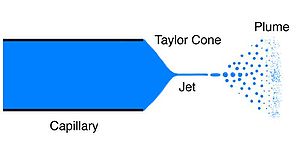
Taylor cone
Encyclopedia

Electrospinning
Electrospinning uses an electrical charge to draw very fine fibres from a liquid. Electrospinning shares characteristics of both electrospraying and conventional solution dry spinning of fibers. The process does not require the use of coagulation chemistry or high temperatures to produce solid...
, electrospray
Electrospray
The name electrospray is used for a device that employs electricity to disperse a liquid or for the fine aerosol resulted in this process. The method is sometimes improperly called electrohydrodynamic atomization. High voltage is applied to a liquid supplied through an emitter...
ing and hydrodynamic spray processes from which a jet of charged particles emanates above a threshold voltage. Aside from electrospray ionization
Electrospray ionization
Electrospray ionization is a technique used in mass spectrometry to produce ions. It is especially useful in producing ions from macromolecules because it overcomes the propensity of these molecules to fragment when ionized...
in mass spectrometry
Mass spectrometry
Mass spectrometry is an analytical technique that measures the mass-to-charge ratio of charged particles.It is used for determining masses of particles, for determining the elemental composition of a sample or molecule, and for elucidating the chemical structures of molecules, such as peptides and...
the Taylor cone is important in FEEP and colloid thruster
Colloid thruster
]A colloid thruster is a type of thruster which uses electrostatic acceleration of charged liquid droplets for propulsion. It is closely related to electrospray ionization and other hydrodynamic spraying processes. In a colloid thruster charged liquid droplets are produced by an electrospray...
s used in fine control and high efficiency (low power) thrust of spacecraft.
History
This cone was described by Sir Geoffrey Ingram TaylorGeoffrey Ingram Taylor
Sir Geoffrey Ingram Taylor OM was a British physicist, mathematician and expert on fluid dynamics and wave theory. His biographer and one-time student, George Batchelor, described him as "one of the most notable scientists of this century".-Biography:Taylor was born in St. John's Wood, London...
in 1964 before electrospray was "discovered". This work followed on the work of Zeleny who, in 1917, photographed a cone-jet of glycerine under high electric field and the work of several others: Wilson and Taylor (1925), Nolan (1926) and Macky (1931). Taylor was primarily interested in the behavior of water droplets in strong electric fields, such as in thunderstorms.
Taylor cone formation

Cone (geometry)
A cone is an n-dimensional geometric shape that tapers smoothly from a base to a point called the apex or vertex. Formally, it is the solid figure formed by the locus of all straight line segments that join the apex to the base...
with a whole angle (width) of 98.6°.. When a certain threshold voltage has been reached the slightly rounded tip inverts and emits a jet of liquid. This is called a cone-jet and is the beginning of the electrospray
Electrospray
The name electrospray is used for a device that employs electricity to disperse a liquid or for the fine aerosol resulted in this process. The method is sometimes improperly called electrohydrodynamic atomization. High voltage is applied to a liquid supplied through an emitter...
ing process in which ions may be transferred to the gas phase. It is generally found that in order to achieve a stable cone-jet a slightly higher than threshold voltage must be used. As the voltage is increased even more other modes of droplet disintegration are found. The term Taylor cone can specifically refer to the theoretical limit of a perfect cone of exactly the predicted angle or generally refer to the approximately conical portion of a cone-jet after the electrospraying process has begun.
Theory
Sir Geoffrey Ingram TaylorGeoffrey Ingram Taylor
Sir Geoffrey Ingram Taylor OM was a British physicist, mathematician and expert on fluid dynamics and wave theory. His biographer and one-time student, George Batchelor, described him as "one of the most notable scientists of this century".-Biography:Taylor was born in St. John's Wood, London...
in 1964 described this phenomenon, theoretically derived based on general assumptions that the requirements to form a perfect cone under such conditions required a semi-vertical angle of 49.3° (a whole angle of 98.6°) and demonstrated that the shape of such a cone approached the theoretical shape just before jet formation. This angle is known as the Taylor angle. This angle is more precisely
 where
where  is the first zero of
is the first zero of  (the Legendre polynomial of order 1/2).
(the Legendre polynomial of order 1/2).Taylor's derivation is based on two assumptions: (1) that the surface of the cone is an equipotential surface and (2) that the cone exists in a steady state equilibrium. To meet both of these criteria the electric field must have azimuthal symmetry and have
 dependence to counter the surface tension to produce the cone. The solution to this problem is:
dependence to counter the surface tension to produce the cone. The solution to this problem is:
where
 (equipotential surface) exists at a value of
(equipotential surface) exists at a value of  (regardless of R) producing an equipotential cone. The angle necessary for
(regardless of R) producing an equipotential cone. The angle necessary for  for all R is a zero of
for all R is a zero of  between 0 and
between 0 and  which there is only one at 130.7099°. The complement of this angle is the Taylor angle.
which there is only one at 130.7099°. The complement of this angle is the Taylor angle.

